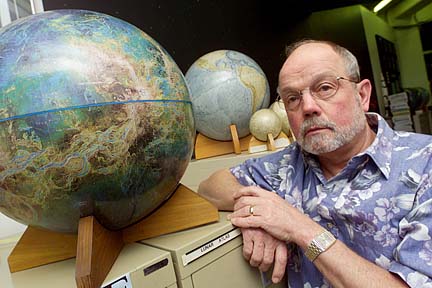


|
The rural Pennsylvania farm boy was driving a truck on a rainy day in December, hauling a load of corn to pour into a conveyor belt for cattle feed. UH professor has
planetary curiosityDr. Thomas McCord had a
humble start but his latest
ventures take him into spaceBy Helen Altonn
haltonn@starbulletin.com"I said, 'There must be something better than this,' and I joined the Air Force," recalls Thomas McCord, University of Hawaii-Manoa professor of planetary sciences and a key figure in NASA space programs since 1976.
After 25 years at UH, he plans to become a professor emeritus, retiring from his position at the end of this month to work on space missions, study planets and "see what develops."
McCord's journey into planetary research began six months after joining the Air Force. "I knew I wanted to be a physicist," he said, explaining his "epiphany" probably was influenced by his father who was always interested in science and chemistry.
His father ended up as a feed salesman after a college fellowship to study chemistry was canceled in the Depression, McCord said. But his father often took him to Philadelphia to visit the Franklin Institute Science Museum and listen to Lowell Thomas lecture about his travels, he said.
McCord studied the moon while earning doctorate degrees in astronomy and planetary science, which drew him into NASA's Apollo lunar program and spectroscopy as a technique to look at planetary objects.
He worked 10 years as one of the first planetary science professors at the Massachusetts Institute of Technology, where he became one of the first non-UH observers at Mauna Kea.
In 1976, he brought 18 people from his MIT research group and two 40-foot containers of equipment to the UH Institute for Astronomy. He was assistant associate director in charge of Mauna Kea operations.
Three years later he moved to the Hawaii Institute of Geophysics, being developed by Chuck Helsley into a modern earth and planetary science facility. McCord formed and directed a planetary geosciences division that gradually expanded and took over the Sinclair Library basement.
This month, McCord got word that he will be one of eight American and three European scientists selected to participate in a $300-million NASA project called the Dawn Mission to study Ceres and Vesta, the largest asteroids in the solar system.
It's hoped Dawn will provide new answers to questions about the formation and evolution of the early solar system.
The Dawn Mission will launch in May 2006. The craft will study Vesta beginning in July 2010 and Ceres beginning in August 2014. Sophisticated equipment will map the entire surface of Ceres and Vesta and measure their magnetic fields, gravity and the chemistry of their surfaces, including the presence of chemicals that develop in the presence of water.
Since he is a specialist on Ceres, McCord will lead the scientific exploration of it.
McCord first became involved with the space program at MIT as a team member for the Galileo Mission in 1976, working on the first visual infrared mapping spectrometer for spacecraft.
Spectrometers provide the information he needs for his research specialty -- the composition of minerals, molecules and materials on planets and what they reveal about how they formed and evolved. Most exciting, he said, are icy satellites such as Titan, Saturn's largest moon.
He was selected for a team to design a series of spectrometers for several NASA missions that ultimately were canceled. Then he was moved as a team leader with the spectrometer for the Cassini Mission, which could not be canceled because of strong European involvement, he said.
Cassini went by Jupiter about a year ago and is due to orbit Saturn in July 2004.
McCord also is a U.S. investigator for the Mars Express Orbiter, led by the European Space Agency and scheduled for launch in June 2003.
It will be orbiting Mars about the same time Cassini is orbiting Saturn, providing an exceptional opportunity to compare the composition of the planets and their satellites, he said.
McCord is particularly interested in looking at Titan with a Visual and Infrared Mapping Spectrometer. Because of a methane atmosphere, the satellite could be "a sea of organic gunk or at least a slimy surface," he said. "We don't know. This is Carl Sagan sort of stuff."
He's involved in other European space programs and a proposed mission to the largest asteroid, Ceres, which has evidence of water escaping from it. "Water is key to me," he said, because it's one of the ingredients needed to form and sustain life.
McCord will be a distinguished visitor for four months at the University of Nantes, going to Cassini-related meetings throughout Europe.
He and his wife, Carol, have had some business interests, including a technology company they developed in 1991. McCord recruited Klaus Keil (now HIGP director) to take his place in the geosciences division and he took a half-time leave of absence to venture into "the classified world" with government contracts for remote sensing.
He went back to research after they sold the company in 1996, and his wife, who was president of the business, became the Maui Supercomputer's first director.
Looking back at his 35 years as a professor, McCord said the most satisfying thing has been his students, now spread around the world.